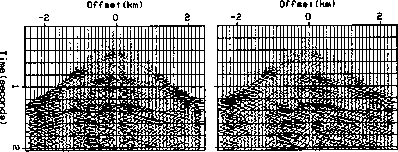It is common for an interpreter looking at a stacked section
to identify a reflected head wave.
Experimentally it is just a hyperbolic asymptote seen in (y,t)-space.
Theoretically, it is a ray that moves away from a source along
a horizontal interface until it encounters an irregularity,
a fault perhaps, from which it reflects and returns toward the source.
Reflected head waves are sometimes called reflected refractions.
This event provides an easy velocity estimate,
namely, ![]() .From a processing point of view,
such a velocity measurement is unexpected,
because automatic processing extracts all velocity information in offset space,
a space which many interpreters prefer to leave inside the computer.
Of course,
for a reflected head wave to be identified, a
special geological circumstance must be present--a
scatterer strong enough to have its hyperbolic asymptote visible.
The point scatterer must also be strong enough to get through
the typical suppression effects of shot and geophone
patterns and CDP stacking.
The most highly suppressed events,
water velocity and ground roll, are just those whose velocities are
most often apparent on stacked sections.
(Recall Larner's streaks).
.From a processing point of view,
such a velocity measurement is unexpected,
because automatic processing extracts all velocity information in offset space,
a space which many interpreters prefer to leave inside the computer.
Of course,
for a reflected head wave to be identified, a
special geological circumstance must be present--a
scatterer strong enough to have its hyperbolic asymptote visible.
The point scatterer must also be strong enough to get through
the typical suppression effects of shot and geophone
patterns and CDP stacking.
The most highly suppressed events,
water velocity and ground roll, are just those whose velocities are
most often apparent on stacked sections.
(Recall Larner's streaks).
Velocity estimates made from reflections are averages of all the layers above the reflection point. To get depth resolution, it is necessary to subtract velocity estimates of different depth levels. Because of the subtraction, accuracy is lost. So with reflected waves, there is naturally a trade-off between accuracy and depth resolution. On the other hand, velocity estimates from head waves naturally have a high resolution in depth.
Processing seems to ignore or discriminate against the backscattered head wave, yet it is often seen and used. There must be an explanation. Perhaps there is also a latent opportunity. From a theoretical point of view, Clayton's cosines showed that at wide angles the velocity and dip sensitivity of midpoint and offset are exchanged. At late times another factor becomes significant: the aperture of a cable length can be much less than the width of a migration hyperbola. So, although it is easy to find an asymptote in midpoint space, there is little time shift at the end of the cable in offset space.
What processing could take advantage of lateral reflectivity
and could enhance, instead of suppress,
our ability to determine velocity in this way?
Start by stacking at a high velocity.
Then use the idea that at any depth z, the
power spectrum of the data ![]() should
have a cutoff
at the evanescent stepout
should
have a cutoff
at the evanescent stepout ![]()
![]() 1 / v ( z ).
This would show up in a plot of
the power spectrum
1 / v ( z ).
This would show up in a plot of
the power spectrum ![]() , or better yet of
the dip spectrum, as a function of depth.
Perhaps it would be still better to visually inspect
the seismic section itself after filtering
in dip space about the expected velocity.
, or better yet of
the dip spectrum, as a function of depth.
Perhaps it would be still better to visually inspect
the seismic section itself after filtering
in dip space about the expected velocity.
The wave-extrapolation equation is an all-pass filter, so why does the power spectrum change with depth? It changes because at any depth z it is necessary to exclude all the seismic data before t=0. This data should be zeroed before computing the dip spectrum. The procedure is depicted in Figure 9.
 |
To my knowledge this method has never been tried. I believe it is worth some serious testing. Even in the most layered of geological regions there are always faults and irregularities to illuminate the full available spectrum. Difficulty is unlikely to come from weak signals. More probably, the potential for difficulty lies in near-surface velocity irregularity.
![]()
 |